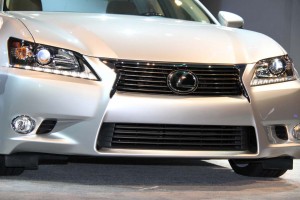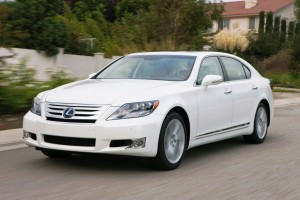
Expect to see some key elements of the newest Lexus GS carry over into the 5th-generation LS - notably including the "spindle grille."
Toyota President Akio Toyoda has been promising to put more “passion” into his company’s products – providing a hint of this new direction with offerings as varied as the new Toyota Avalon, Scion FR-S and the 2012 Lexus GS. But the real test will come when, late this month, the maker’s luxury division lifts the covers off an all-new version of its flagship LS line.
A terse news advisory from Lexus reveals Lexus will unveil the fifth generation of that flagship sedan at an “invitation-only” event taking place in San Francisco on July 30th.
The release notes that the next-gen Lexus LS will be offered in standard and long-wheelbase versions, with an updated version of the LS 600h hybrid and an all-new LS 460 F Sport on tap, as well. Beyond that, it’s a matter of wait-and-see but some insight can be glimmered from recent moves the marque has been making.
At the Pebble Beach preview of the 2013 GS last August, Toyoda-san suggested it was wearing the “new face of Lexus,” which means the 2013 LS variants will share the smaller sedan’s basic spindle grille design. Frequently faulted for its rather tame blend-into-the-crowd styling, the overall look of the new LS should be more dynamic and aggressive, with more angular features and a bolder stance, according to sources familiar with the maker’s styling strategy.
The F Sport, in particular, is expected to feature a distinctly sporty body kit that includes larger wheels and performance tires. It should also get a more nimble suspension set-up, one that, in keeping with Lexus tradition, will allow a fair degree of driver tuneability. The Lexus Dynamic Handling four-wheel-steer system may also be part of the F Sport package.
Maintaining the LS 460 badge suggests that Lexus will stick with a V-8 for the primary powertrain. There’d been rumors the maker might downsize but even the hybrid is expected to deliver a better balance of power and fuel economy than before. Critics crumbled that the outgoing model was more a showpiece than anything else, not delivering the anticipated mileage boost while yet sacrificing any real fun-to-drive character.
The market has clearly changed since the last LS launch, in 2007, German makers amping up their game, delivering more distinctive styling, outside and in, while boosting both performance and fuel economy. And BMW, Mercedes-Benz and Audi all have gone after the classic Lexus selling point by making extensive use of high-tech features to enhance performance, comfort and safety.
While the LS is far from being the brand’s best-seller it remains the Lexus image car, much as the S-Class is for Mercedes, so it needs to be an aspirational offering that will draw potential buyers into showrooms.
As it did when the original LS debuted in 1989 as a 1990 model – and one of two products from the then all-new Lexus brand. The maker reportedly spent $1 billion – and five years – developing the flagship sedan in an effort to take down the established luxury order.
The Gen-1 LS was an immediate hit – much to the surprise of senior German executives – though that had as much to do with its original, $35,000 price tag as anything else, analysts noted at the time. Nonetheless, it helped put the Lexus brand on the map and, with the steady expansion of the line-up the Toyota franchise nudged its way to the top of the luxury charts a decade later.
Lexus slipped off its pedestal last year, though primarily because of production shortages that followed the Japanese earthquake and tsunami last March.
What Toyota ultimately unveils on July 30th will say a lot more than just what it thinks a flagship sedan should look like. It will reveal a lot about the broader brand and its parent – which delivered a shock with the launch of the new Avalon sedan.
“Lexus is leading the way in how the entire Toyota Motor Company should operate,” said President Toyoda last August. Now, he’ll have a chance to prove it.

